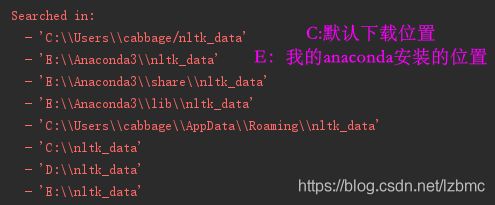【2019-CS224n】Assignment1
Part 1: Count-Based Word Vectors
- NLTK下载数据遇到的坑
- Part 1: Count-Based Word Vectors(基于计数的词向量)
- 导包
- 读取,准备数据
- 创建字典
- 构建共现矩阵
- 降维
- 可视化
- 降维之后的共现图分析
- Part 2 (待更新。。。)
NLTK下载数据遇到的坑
Reuters:路透社语料库(商业和金融新闻)。包括10788篇新闻文献,共计130万字,分为90个主题,按照“训练”和“测试”分为两组。
1、执行下面的代码一直连接失败
import nltk
nltk.download('reuters')
[nltk_data] Error loading reuters:
之前用过nltk.download()没毛病。
2、然后尝试下面方法:

弹出:
还是不行,其实这个和网络关系很大,刚刚试了一下居然成功了。
3、从github下载:nltk_data 这个下载也很慢,半天刷不出来,耐心等待,会弹出下载窗口,然后移动到下面路径中的任意一个

一定要先建“corpora”文件,再把reuters.zip放进去。一开始我直接放到nltk_data下找不到,根据代码情况决定是否解压(我用pycharm运行不解压就可以,但是在Jupyter Notebook不解压报错:No such file or directory: ‘E:\nltk_data\corpora\reuters\test\14829’ ???)

Part 1: Count-Based Word Vectors(基于计数的词向量)
导包
import sys
assert sys.version_info[0] == 3
assert sys.version_info[1] >= 5
from gensim.models import KeyedVectors # KeyedVectors:实现实体(单词、文档、图片都可以)和向量之间的映射。每个实体由其字符串id标识。
from gensim.test.utils import datapath
import pprint # 输出的更加规范易读
import matplotlib.pyplot as plt
plt.rcParams['figure.figsize'] = [10, 5] # plt.rcParams主要作用是设置画的图的分辨率,大小等信息
import nltk
nltk.download('reuters') # 建议github下载
from nltk.corpus import reuters # 导入路透社语料库
from numpy import *
import numpy as np
import random
import scipy as sp
from sklearn.decomposition import TruncatedSVD
from sklearn.decomposition import PCA
START_TOKEN = ''
END_TOKEN = ''
np.random.seed(0)
random.seed(0)
读取,准备数据
def read_corpus(category="crude"):
""" Read files from the specified Reuter's category.
Params:
category (string): category name
Return:
list of lists, with words from each of the processed files
"""
files = reuters.fileids(category) # 类别为crude的文档
# 每个文档都转化为小写,并在开头结尾加标识符
return [[START_TOKEN] + [w.lower() for w in list(reuters.words(f))] + [END_TOKEN] for f in files]
# pprint模块格式化打印
# pprint.pprint(object, stream=None, indent=1, width=80, depth=None, *, compact=False)
# width:控制打印显示的宽度。默认为80个字符。注意:当单个对象的长度超过width时,并不会分多行显示,而是会突破规定的宽度。
# compact:默认为False。如果值为False,超过width规定长度的序列会被分散打印到多行。如果为True,会尽量使序列填满width规定的宽度。
reuters_corpus = read_corpus()
pprint.pprint(reuters_corpus[:3], compact=True, width=100)
创建字典
# 计算出语料库中出现的不同单词,并排序。
def distinct_words(corpus):
""" Determine a list of distinct words for the corpus.
Params:
corpus (list of list of strings): corpus of documents
Return:
corpus_words (list of strings): list of distinct words across the corpus, sorted (using python 'sorted' function)
num_corpus_words (integer): number of distinct words across the corpus
"""
corpus_words = []
num_corpus_words = -1
# ------------------
# Write your implementation here.
flattened_list = [word for every_list in corpus for word in every_list] # 展平成一维
corpus_words = sorted(set(flattened_list)) # set去重,sorted排序
num_corpus_words = len(corpus_words) # 字典总数
# ------------------
return corpus_words, num_corpus_words
# 测试
def test_one():
# Define toy corpus
test_corpus = ["START All that glitters isn't gold END".split(" "),
"START All's well that ends well END".split(" ")]
test_corpus_words, num_corpus_words = distinct_words(test_corpus)
# Correct answers
ans_test_corpus_words = sorted(
list(set(["START", "All", "ends", "that", "gold", "All's", "glitters", "isn't", "well", "END"])))
ans_num_corpus_words = len(ans_test_corpus_words)
# Test correct number of words
assert (num_corpus_words == ans_num_corpus_words), "Incorrect number of distinct words. Correct: {}. Yours: {}" \
.format(ans_num_corpus_words, num_corpus_words)
# Test correct words
assert (test_corpus_words == ans_test_corpus_words), "Incorrect corpus_words.\nCorrect: {}\nYours: {}".format(
str(ans_test_corpus_words), str(test_corpus_words))
# Print Success
print("-" * 80)
print("Passed All Tests!")
print("-" * 80)
构建共现矩阵
def compute_co_occurrence_matrix(corpus, window_size=4):
""" Compute co-occurrence matrix for the given corpus and window_size (default of 4).
Note: Each word in a document should be at the center of a window. Words near edges will have a smaller
number of co-occurring words.
For example, if we take the document "START All that glitters is not gold END" with window size of 4,
"All" will co-occur with "START", "that", "glitters", "is", and "not".
Params:
corpus (list of list of strings): corpus of documents
window_size (int): size of context window
Return:
M (numpy matrix of shape (number of corpus words, number of corpus words)):
Co-occurence matrix of word counts.
The ordering of the words in the rows/columns should be the same as the ordering of the words given by the distinct_words function.
word2Ind (dict): dictionary that maps word to index (i.e. row/column number) for matrix M.
"""
words, num_words = distinct_words(corpus)
M = None
word2Ind = {}
# ------------------
# Write your implementation here.
word2Ind = {k: v for (k, v) in zip(words, range(num_words))}
# print(word2Ind)
M = np.zeros((num_words, num_words))
# !!!一个单词对应字典中的索引和当前文档中的索引,别混了。
for every_document in corpus:
for doc_index, word in enumerate(every_document): # 遍历当前文档中的每个单词及单词在文档中的索引
# print(doc_index, word)
dict_index = word2Ind[word] # 单词对应字典中的索引
for j in range(doc_index - window_size, doc_index + window_size + 1): # 文档中单词的索引位置-4/+4
if j >= 0 and j < len(every_document) and j != doc_index: # 窗口单词范围[0,len(doc))
outer_index = word2Ind[every_document[j]]
M[dict_index, outer_index] += 1
# ------------------
# 老师的答案
# for document in corpus:
# len_doc = len(document)
# for index in range(0, len_doc):
# center_index = word2Ind[document[index]]
# for i in range(index - window_size, index + window_size + 1):
# if i >= 0 and i < len_doc and i != index:
# outer_index = word2Ind[document[i]]
# # print('Incrementing for',document[index],document[i])
# M[center_index, outer_index] += 1.0
return M, word2Ind
def test_two():
# Define toy corpus and get student's co-occurrence matrix
test_corpus = ["START All that glitters isn't gold END".split(" "),
"START All's well that ends well END".split(" ")]
M_test, word2Ind_test = compute_co_occurrence_matrix(test_corpus, window_size=1)
# Correct M and word2Ind
M_test_ans = np.array(
[[0., 0., 0., 1., 0., 0., 0., 0., 1., 0., ],
[0., 0., 0., 1., 0., 0., 0., 0., 0., 1., ],
[0., 0., 0., 0., 0., 0., 1., 0., 0., 1., ],
[1., 1., 0., 0., 0., 0., 0., 0., 0., 0., ],
[0., 0., 0., 0., 0., 0., 0., 0., 1., 1., ],
[0., 0., 0., 0., 0., 0., 0., 1., 1., 0., ],
[0., 0., 1., 0., 0., 0., 0., 1., 0., 0., ],
[0., 0., 0., 0., 0., 1., 1., 0., 0., 0., ],
[1., 0., 0., 0., 1., 1., 0., 0., 0., 1., ],
[0., 1., 1., 0., 1., 0., 0., 0., 1., 0., ]]
)
word2Ind_ans = {'All': 0, "All's": 1, 'END': 2, 'START': 3, 'ends': 4, 'glitters': 5, 'gold': 6, "isn't": 7,
'that': 8, 'well': 9}
# Test correct word2Ind
assert (word2Ind_ans == word2Ind_test), "Your word2Ind is incorrect:\nCorrect: {}\nYours: {}" \
.format(word2Ind_ans, word2Ind_test)
# Test correct M shape
assert (M_test.shape == M_test_ans.shape), "M matrix has incorrect shape.\nCorrect: {}\nYours: {}" \
.format(M_test.shape, M_test_ans.shape)
# Test correct M values
for w1 in word2Ind_ans.keys():
idx1 = word2Ind_ans[w1]
for w2 in word2Ind_ans.keys():
idx2 = word2Ind_ans[w2]
student = M_test[idx1, idx2]
correct = M_test_ans[idx1, idx2]
if student != correct:
print("Correct M:")
print(M_test_ans)
print("Your M: ")
print(M_test)
raise AssertionError(
"Incorrect count at index ({}, {})=({}, {}) in matrix M. Yours has {} but should have {}."
.format(idx1, idx2, w1, w2, student, correct))
# Print Success
print("-" * 80)
print("Passed All Tests!")
print("-" * 80)
# test_two()
降维
def reduce_to_k_dim(M, k=2):
""" Reduce a co-occurence count matrix of dimensionality (num_corpus_words, num_corpus_words)
to a matrix of dimensionality (num_corpus_words, k) using the following SVD function from Scikit-Learn:
- http://scikit-learn.org/stable/modules/generated/sklearn.decomposition.TruncatedSVD.html
Params:
M (numpy matrix of shape (number of corpus words, number of corpus words)): co-occurence matrix of word counts
k (int): embedding size of each word after dimension reduction
Return:
M_reduced (numpy matrix of shape (number of corpus words, k)): matrix of k-dimensioal word embeddings.
In terms of the SVD from math class, this actually returns U * S
"""
n_iters = 10 # Use this parameter in your call to `TruncatedSVD`
M_reduced = None
print("Running Truncated SVD over %i words..." % (M.shape[0]))
# ------------------
# Write your implementation here.
svd = TruncatedSVD(n_components=k, n_iter=n_iters, random_state=0)
# svd.fit(M) # 训练数据
# M_reduced = svd.transform(M) # 降维
M_reduced = svd.fit_transform(M) # 等价于上面两句
# print(M_reduced) # 二维矩阵
# ------------------
print("Done.")
return M_reduced
def test_three():
# ---------------------
# Run this sanity check
# Note that this not an exhaustive check for correctness
# In fact we only check that your M_reduced has the right dimensions.
# ---------------------
# Define toy corpus and run student code
test_corpus = ["START All that glitters isn't gold END".split(" "),
"START All's well that ends well END".split(" ")]
M_test, word2Ind_test = compute_co_occurrence_matrix(test_corpus, window_size=1)
M_test_reduced = reduce_to_k_dim(M_test, k=2)
# Test proper dimensions
assert (M_test_reduced.shape[0] == 10), "M_reduced has {} rows; should have {}".format(M_test_reduced.shape[0], 10)
assert (M_test_reduced.shape[1] == 2), "M_reduced has {} columns; should have {}".format(M_test_reduced.shape[1], 2)
# Print Success
print("-" * 80)
print("Passed All Tests!")
print("-" * 80)
# test_three()
可视化
# 降维之后可视化
def plot_embeddings(M_reduced, word2Ind, words):
"""
Plot in a scatterplot the embeddings of the words specified in the list "words".
NOTE: do not plot all the words listed in M_reduced / word2Ind.
Include a label next to each point.
Params:
M_reduced (numpy matrix of shape (number of unique words in the corpus , k)): matrix of k-dimensioal word embeddings
word2Ind (dict): dictionary that maps word to indices for matrix M
words (list of strings): words whose embeddings we want to visualize
"""
# ------------------
# Write your implementation here.
# 需要得到每个单词的x,y坐标。
# 单词:words。 x,y:M_reduced的[[x,y],[x,y]]
for word in words:
x = M_reduced[word2Ind[word]][0]
y = M_reduced[word2Ind[word]][1]
plt.scatter(x, y, marker='x', color='red') # marker:表示的是标记的样式,默认的是'o'。
# plt.text()给图形添加文本注释
plt.text(x+0.0002, y+0.0002, word, fontsize=9) # x、y上方0.002处标注文字说明,word标注的文字,fontsize:文字大小
plt.show()
# ------------------
def test_four():
# The plot produced should look like the "test solution plot" depicted below.
# ---------------------
print("-" * 80)
print("Outputted Plot:")
M_reduced_plot_test = np.array([[1, 1], [-1, -1], [1, -1], [-1, 1], [0, 0]])
word2Ind_plot_test = {'test1': 0, 'test2': 1, 'test3': 2, 'test4': 3, 'test5': 4}
words = ['test1', 'test2', 'test3', 'test4', 'test5']
plot_embeddings(M_reduced_plot_test, word2Ind_plot_test, words)
print("-" * 80)
# test_four()
降维之后的共现图分析
def plot_analysis():
# -----------------------------
# Run This Cell to Produce Your Plot
# ------------------------------
reuters_corpus = read_corpus() # 二维列表数据
M_co_occurrence, word2Ind_co_occurrence = compute_co_occurrence_matrix(reuters_corpus) # 共现矩阵,字典
M_reduced_co_occurrence = reduce_to_k_dim(M_co_occurrence, k=2) # 降维
# Rescale (normalize) the rows to make them each of unit-length
# 重新缩放(规格化)这些 行(axis=1),使它们成为每个单元长度
M_lengths = np.linalg.norm(M_reduced_co_occurrence, axis=1) # 8185个词--8185行。一维
# print(shape(M_reduced_co_occurrence)) # (8185, 2)
# print(shape(M_lengths[:, np.newaxis])) # 二维(列)(8185, 1)
# numpy的broadcasting知识:https://jakevdp.github.io/PythonDataScienceHandbook/02.05-computation-on-arrays-broadcasting.html
M_normalized = M_reduced_co_occurrence / M_lengths[:, np.newaxis] # broadcasting
words = ['barrels', 'bpd', 'ecuador', 'energy', 'industry', 'kuwait', 'oil', 'output', 'petroleum', 'venezuela']
plot_embeddings(M_normalized, word2Ind_co_occurrence, words)
plot_analysis()



